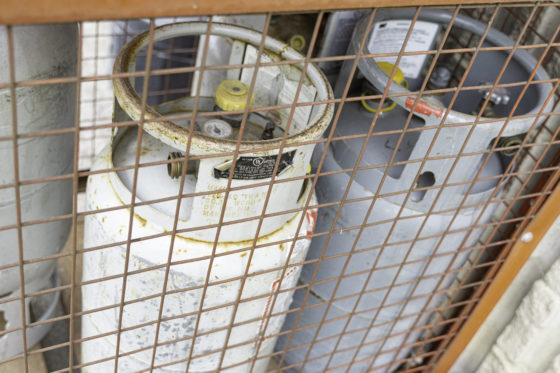Workers have been injured in fires after unsecured propane cylinders tipped over and ignited. Securing cylinders and other safe practices are essential.

Photo credit: iStock.com/Osarieme Eweka
In June 2019, two people were injured while pressure washing a poultry processing unit. The pressure washer was powered by an unsecured propane tank that fell over and released gas, which then ignited.
“Compressed propane is a hazardous product and any type of leakage or breakage, or unwanted escape of the gases, can result in a fire,” says Jack Marra, an occupational safety officer with WorkSafeBC. “But because we use it so often — at home and at work — people might not realize how dangerous it can be.”
It’s essential that employers ensure propane tanks are secured by placing them in a stand, for example. Propane cylinders generally have a protective cage attached to the top of them to ensure regulators and valves are not impacted or damaged if the cylinder tips over, says Jack. If the regulators and valves are exposed outside this protective cage, it could lead to a rupture and propane leak.
Using propane while roofing
In another incident, workers installing roofing material were injured when the propane torch system they were using tipped over and caught on fire. In this “torch-on roofing” process, workers use open-flame propane torches to weld pieces of roofing material together to create waterproof membrane on flat roofs. During workplace inspections, Jack occasionally sees people working on roofs with unsecured propane cylinders.
He says: “There’s only a certain amount of the roof you can cover with a 50-foot hose. You’ve got to be continually lifting and moving the cylinders and people can get complacent about the risk of a tank tipping over.”
In addition to securing propane cylinders, here are some other safe work practices Jack discusses with roofing employers:
- Watch for slipping and tripping hazards. This includes the propane tanks, lines, and torches.
- Ensure the propane hose is in good condition. Says Jack: “The hose can be subject to a significant amount of damage and abrasion on a roof. If it pops a leak, then you’ve a hazardous leak that’s basically combustible.”
- Do not use too long of a hose between the cylinder and the torch. “The longer the hose, the greater the chance that the gas will liquefy in the hose. You’ve got a dangerous situation if the gas liquefies in the hose, then fires out the nozzle. Employers need to be aware of the hazards of placing a large propane tank on the ground and running long hoses to the roof.”
- Consider using a hot-air welding system. Jack says a number of larger employers are using this system that’s known to be safer and more efficient. It does not require an open flame.
- Thing about safety when transporting propane cylinders to the site and onto the roof. “Always ensure propane tanks are secured during transport to the site and not freely rolling in the back of a truck. Make sure there is a safe mechanism for lifting the propane cylinders onto the roof as well.”
For more information about working safely with propane and other compressed gas cylinders, see Compressed gas cylinders, a toolbox meeting guide from WorkSafeBC. Also see my posts, Helping food truck owners put propane safety on the menu and Storing and using portable propane tanks safely.


